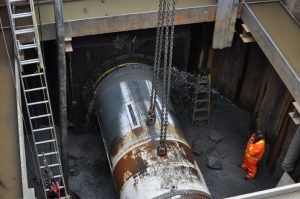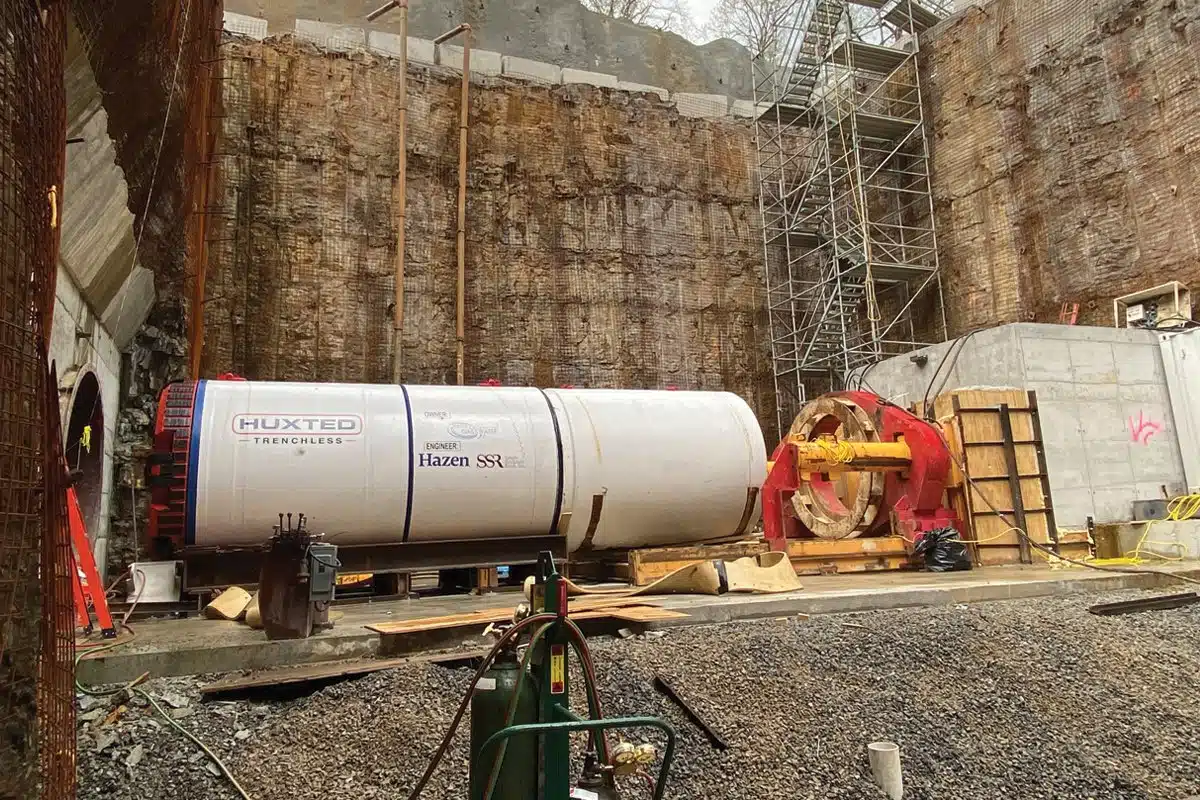
Microtunnelling Under the Mary Hill Bypass
May 22, 2017
An emerging methodology in British Columbia, microtunnelling is earning its stripes as a unique way to complete critical infrastructure links in circumstances that might otherwise be considered unbuildable.In 2016, Michels Canada used microtunnelling to successfully construct a 145-m long tunnel under the heavily traveled Mary Hill Bypass roadway in Coquitlam, B.C., east of Vancouver. Michels navigated substantial challenges to build the 1,829-mm diameter tunnel in just two months, allowing the general contractor, Pedre Contractors, to stay on schedule.

On the Mary Hill Bypass microtunnelling project, Michels combined proper planning, procedures and execution to overcome issues and turn an uncertain project into a success.
The tunnel, an essential portion of Metro Vancouver’s 2,200-m Port Mann Main No. 2, serves as a casing for a 1,524-mm diameter water main that will twin with an existing water main to expand service to the metropolitan Vancouver area.
Based in Nisku, Alberta, Michels Canada is a diversified utility contractor that serves oil and gas, power delivery, sewer and water, and heavy civil construction markets throughout Canada. The company is accomplished in many trenchless construction methods, including microtunnelling.
Proper planning is an important step of any project’s successful execution. In ideal situations, Michels’ trenchless technology team gets involved in the early planning stages, allowing opportunities to share insights, make recommendations and adapt Michels’ comprehensive procedures to the specifications of a particular project.
However, due to myriad reasons, that is not always possible. In many instances, Michels project managers and crews are asked to join projects in the latter stages. When that happens, the Michels team draws upon its past experiences and established procedures to partner with the customer, assess the project and its unique details, and mobilize the personnel and equipment needed to safely and efficiently execute the project.
RELATED: Crossing the Athabasca River in Canada
Such was the case with the Mary Hill Bypass tunnel project, for which Michels was engaged soon before tunnelling operations were scheduled to commence. To keep the project on schedule, Michels worked in launch and exit shafts that were built before Michels joined the team.
The sheet pile launch pit measured 13 m long by 7 m wide and 7.5 m deep with a 600-mm base poured by tremie method. Because the shaft was not built specifically for the Akkerman SL74 microtunnel boring machine (MTBM) Michels planned to use on the project, Michels modified the shaft’s shoring system to fit the MTBM and related equipment and to allow for safe operations.
Additional adjustments were needed to accommodate the Permalok pipe that had already been ordered. Typically, the outside diameter of the pipe and the MTBM’s cut are matched to minimize the amount of overcut. However, in this instance, the outside diameter of the 15.8-mm wall steel pipe was significantly smaller than the 1,918-mm cut of the MTBM. An overcut of more than an inch is not ideal in even the most favourable conditions; on this project, it presented a significant hurdle.
The area’s flowing soil increased the chance of having settlement around the overcut extend up to the surface. Given that a highly-travelled highway was located no more than 14 m above the tunnel’s path, Michels developed a specific slurry program, assigned a veteran operator to helm the challenging drive, and took additional steps to mitigate the risk of settlement. In the end, Michels and the customer agreed that microtunnelling had the highest possibility of successfully installing the pipe without causing major disruptions.
RELATED: Tippets Joins Michels Corp. as Microtunneling Manager
The high groundwater levels in the area required attention throughout all phases of construction. Because water levels were 1.5 m below the surface elevation and were heavily influenced by the nearby Fraser River, the general contractor installed a wellpoint dewatering system to relieve pressure from the base slab in the launch shaft and to assist with the launch and retrieval of the MTBM.
After completing thorough preparations, the Michels team began mining operations, being vigilant about keeping the hole open and keeping annular space filled with precisely pressurized slurry. In general, the soft ground MTBM easily handled and processed the sandy, silty soil and gravel seams. Production was slowed at one point when the MTBM encountered previously undetected wooden piers, but even that was no match for the powerful machine.
Maintaining the alignment is critical in tunnelling and, with proper equipment and skilled operators, it is an extremely accurate method. Working in an urban area like this bypass tested Michels’ deft navigational skills and the machine’s steering systems to avoid existing utilities and structures, including a drainage ditch bed.

Additional adjustments were needed to accommodate the Permalok pipe that had already been ordered. Typically, the outside diameter of the pipe and the MTBM’s cut are matched to minimize the amount of overcut. However, in this instance, the outside diameter of the 15.8-mm wall steel pipe was significantly smaller than the 1,918-mm cut of the MTBM.
Once again proving to be up to the challenge, Michels completed the project within a 9-mm variance of the predetermined line and grade, far under the customer’s allowable tolerances.
For this project, the Michels project management team understood the importance of completing its work on schedule so as not to negatively impact the overall project.
Given a tight, two-month window from mobilization to completion meant that Michels team was constantly vigilant about maintaining its schedule, even when dealing with unexpected circumstances.
This was achieved by relying on the experiences of the crew in the field and the support of teams at Michels Canada’s headquarters in Nisku, Alberta, and Michels’ U.S-based operations.
RELATED: Project of The Year- New Installation: HDD & the Houston Ship Channel
Many facets play into each individual project’s outcome. On the Mary Hill Bypass microtunnelling project, Michels combined proper planning, procedures and execution to overcome issues and turn an uncertain project into a success.
Mike Davolt is a Michels Canada project manager. He has more than a decade of experience with microtunnelling and tunnelling projects across North America.




